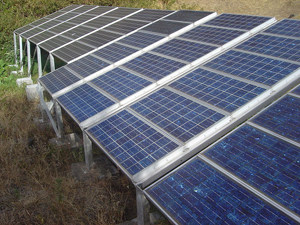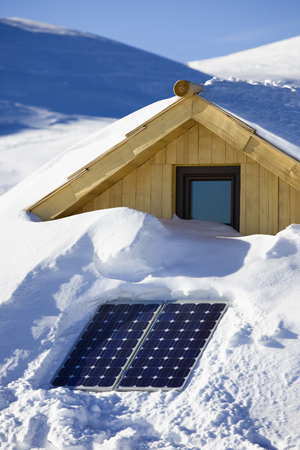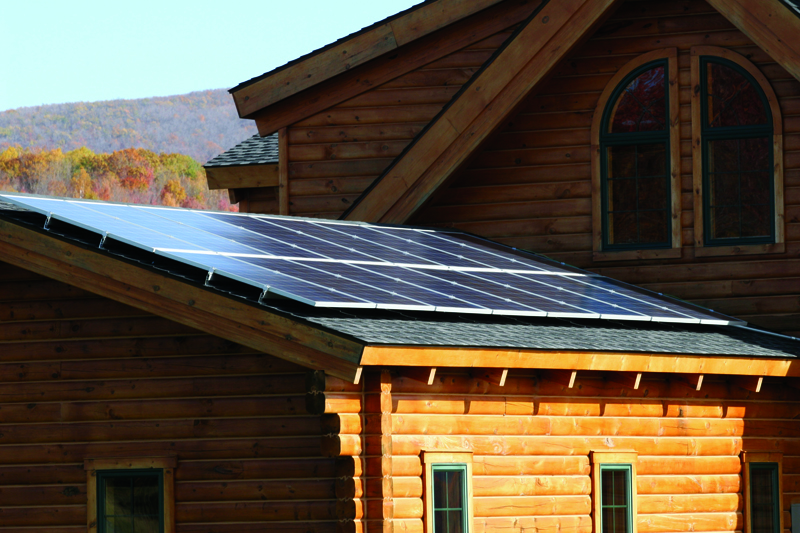If you are planning to build a new log home, now is a great time to think about energy efficiency and your carbon footprint. Log homes are already energy efficient because of the thermal mass of the logs—they require less energy to heat and cool. But there is a lot more you can do to hold your energy costs down and make your home both comfortable and healthy to live in. In this issue, we’re looking at solar energy, particularly the use of photovoltaic panels.
Why Go Solar?
Energy from the sun is renewable, clean, affordable, and adaptable to almost any home. It does not rely on petrochemicals or damage the environment in any way. Using solar collectors can cover all or part of your electrical needs and protect you from rising utility rates in the future. Photovoltaic (PV) panels are reliable and have a long life span with warranties from 15 to 25 years. PVs were developed for use in space and have been used on satellites for more than 30 years. If you live in an area prone to blackouts, your PV system can be configured to bring limited power to your home when you need it. The PV system itself is also eco-friendly: the panels are made of silica—common sand—and the frames used to mount them are constructed of recycled aluminum cans. The cost of a PV system has come down in recent years, and innovative solar products enter the marketplace every year. In addition, both federal and state governments and local utility companies may offer incentives to those who want to install a solar electric system.
Taking the First Steps
The most important initial step is to determine whether your building site is suitable for solar energy, and for this it is a good idea to consult with a solar energy expert. The solar array needs maximum southern exposure to the midday sun during all seasons. If you choose a roof-mounted system, the roof of your home must be oriented on an east-west axis. If the array will be separate from the home, there must be an appropriate space for it as close to the home as possible, ideally no more than 100 feet away.
Another important step comes with the selection of your log home producer. Several log home companies offer a solar package with their homes. They have the expertise to select the right PV system for your energy needs and to integrate it into your log home. If the log home producer does not offer a solar package, the company will be more than willing to work with a solar energy installer to ensure that your system runs perfectly. Adding a PV system to a log home is no more difficult that installing a standard HVAC system, but requires a different sort of expertise. The weight of the panels is negligible, but a PV set-up has special requirements in the utility room.
If you plan to build in a log home community or another type of neighborhood, make sure they allow you to put solar panels on your home and that you have the proper permits for the system.

Premier Power Renewable Energy, Inc
On or Off the Grid?
The idea of living completely off the grid—that is, being totally self-sufficient in terms of electricity, heating and cooling, and water—may appeal to your pioneering, environmentally conscious spirit, but it requires dedication, conservation, and a hefty initial financial investment. Chances are that you will need to take advantage of other forms of natural energy—wind, water, geothermal, and passive solar—as well as natural gas or propane to keep your home running at peak efficiency. Environmental concerns aside, people often decide to live off the grid because they are building in an extremely isolated location and the cost of bringing utilities to the site is prohibitive.
Living off the grid is not your only option. There are different degrees of self-sufficiency that may work better for you. First, with the direct-grid tie system, there are no energy storage batteries in or near your home; you are tied to the grid, which acts a like a battery that absorbs extra energy gained from the PV system and makes up for any shortfalls. On the plus side, this system is simple and relatively inexpensive. On the minus side, if there is a power failure or the grid fails, your system will shut down.
The grid-tie system with batteries works much like the direct-grid tie system as long as grid power is available. If there is a power failure or the grid fails, an inverter switches to battery power and keeps critical devices running. You’ll need a critical-loads subpanel to isolate those critical devices, such as the refrigerator/freezer, furnace, and some lights, during a blackout. This system uses somewhat more energy to keep the batteries charged.
If you are tied to the grid through a power line, you may be able to get a credit for your excess energy, that is, the energy left over after all of your home’s electrical needs have been met. To do this, you need a “net metering” arrangement with your local utility company. Conversely, if your PV system cannot meet all of your electrical needs, you simply take the power you need from the utility.
How Does It Work?
Photovoltaic materials and devices convert light energy into electrical energy. Individual PV cells, or solar cells, are made of semiconductor materials that come in many sizes and shapes. When they are connected, they form PV modules that may be several feet long and a few feet wide. Modules are then combined into PV arrays. The size and power output of an array are determined by your needs as a consumer and the amount of sunlight available in your location. The PV array is just one part of a complete PV system. The other components are:
• Battery charge controller. The battery charge controller regulates the electricity that comes from the PV panels. It reads the status of the batteries and makes sure they get the proper voltage.
• DC switchboard. This contains the meters and circuit breakers that control the DC system. The DC current created by the PV array goes through the controller and through the DC switchboard.
• Battery bank. The battery bank stores the electricity collected from the sun. The size of the battery bank depends on how long you want to run the house when the grid fails or there is a power outage.
• Inverter. PV cells convert sunlight into direct current (DC) electricity. The inverter converts the DC electricity into AC so it can be used by most standard appliances and computers.
• AC switchboard. Like a typical breaker box, the AC switchboard houses circuit breakers, safety switches, cutouts, and leakage breakers.

Before you even begin designing your log home, you’ll need to design your PV system so you know how much space you’ll need for all of the components. Most states and communities have strict regulations for placement of some of the components. For example, the battery bank contains acid and may give off toxic fumes, so it needs to be kept in a well-ventilated area or be vented to the outside of the house via a small-diameter pipe. You’ll need to allow space to expand your battery bank at some point in the future. Most people prefer to locate the electrical room in the basement of their home, but also consider a separate shed close to or attached to the house. To make sure everything runs properly and safely, it is essential to consult an expert.
Up On the Roof?
If your home is oriented on an east-west axis, then putting your solar array on the southern-facing side of the roof may be ideal for you. Have a solar installation professional do the work to insure that the warranties are in place. The installation should take place right after the roof is finished. If the builder’s scaffolding is still, up it will make the installation easier and possibly less expensive. The type of roofing you select will affect the type of mounting connections used; metal or composition shingle roofs are the easiest, and wood shingles are more challenging because they tend to split. Ideally, you should decide on your roofing material during the design process with expert advice from your builder/contractor or roofing company. It is important to install the array in the best method possible to avoid leaks, loose panels, or shingles or metal falling off.
The down side of a roof-mounted system is that the panels need to be kept clean and free of leaves, dust, or snow, and clearing them on the roof may present a few problems. With a ground-mounted system, the panels are mounted on poles or on racks closer to the ground, allowing easy access at all times. Some PV systems allow the angle of the panels to be manually adjusted on a seasonal basis so maximum sun exposure is maintained. Or you can install a motorized solar tracking system that operates on a timer and turns the panels to follow the sun all day.
Take the Leap!
There has never been a better time to consider a photovoltaic system for your home. With energy costs on the rise and air quality deteriorating, why not harness a clean, renewable energy source to power your home? Don’t feel you have to leap in with both feet. You can start small and add to your system over time. With increasing federal and state incentives, the cost of installing your PV system is coming down, and the potential to offset these costs in a short time is better than ever. Take advantage of the extensive resources available to you on the Web and in books, and talk with PV installers in your area. Last but not least, consult with your log home producer, who wants to help you achieve your dream log home.

